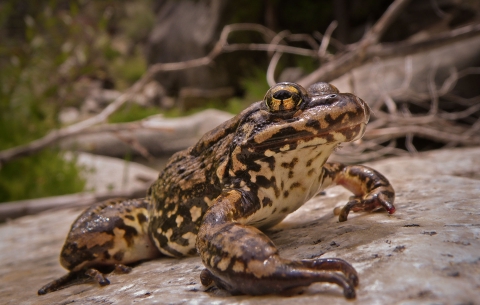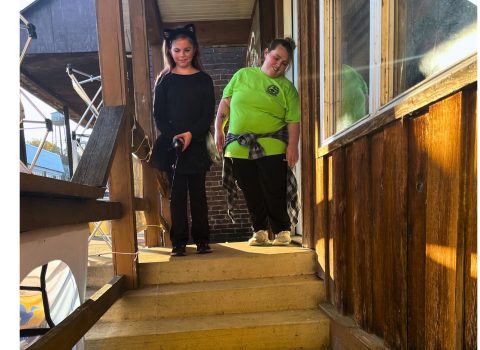Not too long ago there were only 100 mountain yellow-legged frogs remaining in their native habitats of southern California.
This pint-size, brownish-yellow frog is one of the last remnants of “true” frogs native to southern California. True frogs spend their entire life, from egg to tadpole to adult, in water or very close to it. In fact, they are almost always spotted within a few feet of water, whether it is a pond, lake shore or stream bank.
The mountain yellow-legged frog occurs in two distinct groups - one is found in the mountains of southern California and the other in the Sierra Nevada Mountains. Although their habitats vary significantly, both populations of frogs face similar threats like predation from non-native fish and decreasing habitat.
In southern California, mountain yellow-legged frogs once numbered in the thousands, inhabiting streams like Pacoima Creek in Los Angeles County and Pauma Creek in San Diego County.
By 1994, that had changed. Southern mountain yellow-legged frog numbers declined much more steeply and dramatically than their northern counterparts, and scientists determined the population was gone from 99 percent of its historic habitat.
Across the San Gabriel, San Bernardino and San Jacinto Mountains, the frog has faced mounting obstacles, with the introduction of nonnative trout being just one. Their need for habitat in and near water makes them susceptible to both flood and drought. The frogs also are sensitive to wildfire, pollution, disturbance from recreation, chemical run-off from illegal marijuana plantations and a disease called chytridiomycosis, a fungus threatening many species of frogs on a global scale.
When the U.S. Fish and Wildlife Service listed the frog under the Endangered Species Act in 2002, the species only occupied seven of 166 previous sites in southern California.
The Old Fire, which burned thousands of acres in San Bernardino County in 2003, raised more alarms about the frogs’ survival. Service experts thought the erosion from the post-fire rains would wipe out the remaining few individual frogs in City Creek, one of the seven remaining occupied sites. However, biologists from the U.S. Forest Service and U.S. Geological Survey stepped in and rescued 11 adult frogs from City Creek and transported them to the Los Angeles Zoo.
OUT OF ADVERSITY, COMES AN OCCASIONAL GIFT
In this case, the rescue of the frogs from City Creek helped researchers learn more about the species’ lifecycle and provided valuable information that led to the establishment of a successful captive-breeding program in 2010.
Both San Diego Zoo Global and the Los Angeles Zoo participate in the captive breeding program. Eggs, tadpoles and young frogs are released into their historic range annually with the participation of three national forests - Angeles, San Bernardino and Cleveland as well as the University of California’s Natural Reserve System.
Along with the captive breeding program, the Service has worked with partners to reduce threats to the species in its wild habitat. The removal of non-native trout and creation of fish barriers in some locations has decreased predation of the frogs. Other actions have included moving recreation sites like campgrounds and picnic areas out of frog habitat.
However, the captive breeding program remains the most novel part of this recovery story. As Jesse Bennett, wildlife biologist for the Service’s Carlsbad Office puts it, “One of the driving forces for our captive breeding program was desperation, given the low number of frogs remaining in the wild. This was a last resort.”
"We don’t know for sure if the captive breeding program will work, Bennet said. It will take time to understand if releasing captive-bred frogs into the wild is the golden ticket for recovery, but we do know it is helping. Some of the young captive-bred and released frogs have bred in the wild, and tadpoles have been found at some of the release locations.
Despite countless odds, including imminent extinction, the endangered mountain yellow-legged frog of southern California can rest a little easier knowing there are fewer ravenous trout scouting for a meal and more opportunities to court a mate, thanks to the many partners working on these recovery efforts.




